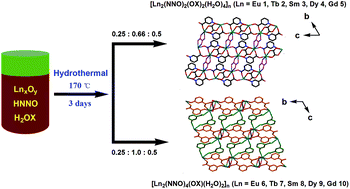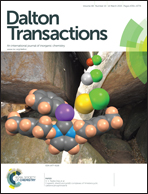Two series of reactant's ratio-dependent lanthanide organic frameworks derived from nicotinic acid N-oxide and oxalate: synthesis, crystal structures and luminescence properties†
Abstract
Two series of lanthanide(III)–organic frameworks with the molecular formula [Ln2(NNO)2(OX)2(H2O)4]n (Ln = Eu 1, Tb 2, Sm 3, Dy 4, Gd 5) and [Ln2(NNO)4(OX)(H2O)2]n (Ln = Eu 6, Tb 7, Sm 8, Dy 9, Gd 10) were synthesized successfully under the same hydrothermal conditions with nicotinic N-oxide (HNNO) and oxalic acid (H2OX) as the mixed ligands merely through varying the molar ratio of the reactants. The compounds were characterized by IR, elemental analysis, UV, TG-DTA and powder X-ray diffraction (XRD). X-ray single-crystal diffraction analyses of compounds 1 and 7 selected as representatives and powder XRD analysis of the compounds revealed that both the series of compounds feature three-dimensional (3-D) open frameworks, and crystallize in the triclinic P![[1 with combining macron]](https://www.rsc.org/images/entities/char_0031_0304.gif) space group while with different unit cell parameters. In compound 1, pairs of Eu3+ ions and pairs of NNO− ligands connect with each other alternately to form a 1-D infinite Eu-NNO double chain, the adjacent 1-D double-chains are then joined together through OX2− ligands leading to a 2D layer, the 2-D layers are further ‘pillared’ by OX2− ligands resulting in a 3-D framework. In compound 7, the 1-D Tb-NNO infinite chain and its 2-D layer are formed in an almost similar fashion to that in compound 1. The difference between the structures of the two compounds 1 and 7 is that the adjacent 2-D layers in compound 7 are further connected by NNO− ligands resulting in a 3-D framework. The photoluminescence properties and energy transfer mechanism of the compounds were studied systematically. The energy level of the lowest triplet states of the HNNO ligand (23 148 cm−1) was determined based on the phosphorescence spectrum of compound 5 at 77 K. The 5D0 (Eu3+) and 5D4 (Tb3+) emission lifetimes are 0.46 ms, 0.83 ms, 0.69 ms and 0.89 ms and overall quantum yields are 1.03%, 3.29%, 2.58% and 3.78% for the compounds 1, 2, 6 and 7, respectively.
space group while with different unit cell parameters. In compound 1, pairs of Eu3+ ions and pairs of NNO− ligands connect with each other alternately to form a 1-D infinite Eu-NNO double chain, the adjacent 1-D double-chains are then joined together through OX2− ligands leading to a 2D layer, the 2-D layers are further ‘pillared’ by OX2− ligands resulting in a 3-D framework. In compound 7, the 1-D Tb-NNO infinite chain and its 2-D layer are formed in an almost similar fashion to that in compound 1. The difference between the structures of the two compounds 1 and 7 is that the adjacent 2-D layers in compound 7 are further connected by NNO− ligands resulting in a 3-D framework. The photoluminescence properties and energy transfer mechanism of the compounds were studied systematically. The energy level of the lowest triplet states of the HNNO ligand (23 148 cm−1) was determined based on the phosphorescence spectrum of compound 5 at 77 K. The 5D0 (Eu3+) and 5D4 (Tb3+) emission lifetimes are 0.46 ms, 0.83 ms, 0.69 ms and 0.89 ms and overall quantum yields are 1.03%, 3.29%, 2.58% and 3.78% for the compounds 1, 2, 6 and 7, respectively.


 Please wait while we load your content...
Please wait while we load your content...